Today’s post is a bit late, for which I apologize. It also offers a break from some of the more weighty topics I’ve covered in my Monday posts. I sometimes feel that I get too serious with my essays week after week, and though I know people enjoy the Musings posts, I also don’t want to be a downer.
Nancy and I have been streaming some new stuff so far this year. For a time, some of you may remember, we were new to the world of streaming (and new to the world of high-speed internet) and were just trying to catch up on the shows everyone was talking about. At this point, we have worked our way through some of the well-known stuff — Ted Lasso, The Marvelous Mrs. Maisel, The Crown, and others. We have enjoyed them (mostly — the most recent season of The Crown left us cold; we didn’t finish it) and are new venturing into newer shows and other titles that we’re finding interesting. I should mention here that we currently have access to Netflix, Prime, Disney+, and Apple TV. We have not yet ventured into Paramount+ or HBO Max, though we intend to eventually.
With that in mind, here are a few of our recent favorites:
The Diplomat — Netflix: Keri Russell and Rufus Sewell as a dysfunctional couple who are both high-profile diplomats. He is undisciplined and currently out of work; she is newly assigned as the ambassador to London, a position that should be low key and cushy but proves anything but. His jealousy of her success and his repeated attempts to manipulate events behind the scenes threaten to wreck their marriage, despite the electric bond between them. The dynamic between the two is fascinating and compelling, the acting is terrific, as is the supporting cast. One season is done, and the show has been renewed for another.
The Night Agent — Netflix: Gabriel Basso plays a low-level FBI agent who answers a late-night call from a young woman (played by Luciane Buchanan) being hunted by the killers who, for reasons she doesn’t understand, have just murdered her aunt and uncle. Events quickly point toward a mole in the White House and a deadly plot against the U.S. government. You don’t want to think too hard about any of what happens, because there are definitely plot holes. And the scripts are not about win any Pulitzers. But the chemistry between Basso and Buchanan is terrific, and the storyline is compelling enough to pull one along for all 10 first season episodes. One season is done; show renewed for another.
The Last Kingdom — Netflix: A historical series set in England at the time of King Alfred (before there actually was an England). Alexander Dreymon plays Uhtred of Bebbanburg, a Saxon-born man who was raised by invading Danes and finds himself caught again and again between Danish warriors and the Saxons who seek to establish a kingdom that will unite all of England. The action can be brutal, bloody, and gruesome, and there is a good deal of explicit sex. But if you’re okay with that, this is interesting, suspenseful, and really well-acted. Highly recommended. Five seasons complete and a final movie, Seven Kings Must Die, also on Netflix.
Star Wars: Andor — Disney+: This entry in the Star Wars mythos is one that I watched while Nancy was traveling, and it really surprised me. I was sort of lukewarm on The Mandalorian and expected to feel the same way about this series, which traces the early years of Cassian Andor’s (Diego Luna) initiation into the rebel cause. For those who don’t know, Andor was one of the lead characters in the Star Wars movie Rogue One. This show serves as a prequel to that, and to the original Star Wars movie. As it turns out, the show is thoughtfully done, and the performances are quite good. I offer this along with all the usual caveats about anything Star Wars-related. Rabid fans of the franchise will already know about this series, but if you’re a casual fan of the movies, you’ll probably enjoy this as well. One season, renewed for a second.
Derry Girls — Netflix: Brilliant, hilarious, and utterly bingeable. This show originally aired on Irish TV, where it was a huge hit. You can now watch it on Netflix. It follows a group of high school kids living in Northern Ireland during the 1990s as the Troubles continue to consume the land. The humor is spot on, making the occasional moments of serious drama are all the more effective. The ensemble cast is quirky and perfect. The episodes are only 30 minutes long and there are only three seasons of the show, making it easy to get through in a long weekend. You won’t be sorry. Oh, turn on close captioning when you watch; the accents are thick. Three seasons. Complete.
Lockwood and Co. — Netflix: We’re watching this one now. Based on the novels by Jonathan Stroud, Lockwood and Co. follows three teens who fight supernatural spirits in a dystopian future London. The teens are portrayed quite well by Ruby Stokes, Cameron Chapman and Ali Hadji-Heshmati, and thus far (five episodes in) the storyline is certainly fun and intriguing enough to hold our interest. There are some plot holes, but the action and dialogue move things along quickly enough to keep one from dwelling on them for too long. Unfortunately, the series was cancelled after one season (10 episodes). One season; cancelled.
And there we are.
Have a great week.









 First, though, it occurs to me that in writing about openings last week, I left out one crucial, but easy-to-describe story element: “the inciting event.” The inciting event of your narrative is, quite simply, the thing that jump-starts your story, that takes the characters you have introduced in your opening lines from a place of relative stasis to a place of flux, of change, of tension and conflict and, perhaps, danger. It is the commencement of the narrative path that will carry your characters through the rest of the story. In his description of the Hero’s Journey, Joseph Campbell referred to the inciting event as the “Call to Adventure.” If you’re looking for examples, think of the arrival of the first letter from Hogwarts in Harry Potter and the Sorcerer’s Stone, or the appearance of Gandalf at Bilbo Baggins’s door in The Hobbit. In pretty much all the Thieftaker books and stories, it is the arrival of whoever Ethan’s new client will be for that episode.
First, though, it occurs to me that in writing about openings last week, I left out one crucial, but easy-to-describe story element: “the inciting event.” The inciting event of your narrative is, quite simply, the thing that jump-starts your story, that takes the characters you have introduced in your opening lines from a place of relative stasis to a place of flux, of change, of tension and conflict and, perhaps, danger. It is the commencement of the narrative path that will carry your characters through the rest of the story. In his description of the Hero’s Journey, Joseph Campbell referred to the inciting event as the “Call to Adventure.” If you’re looking for examples, think of the arrival of the first letter from Hogwarts in Harry Potter and the Sorcerer’s Stone, or the appearance of Gandalf at Bilbo Baggins’s door in The Hobbit. In pretty much all the Thieftaker books and stories, it is the arrival of whoever Ethan’s new client will be for that episode. Trust your reader.
Trust your reader.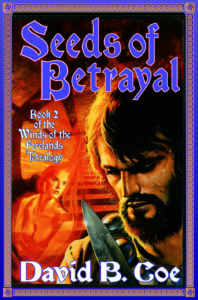 As I say, “trust your reader” is essentially the same as “trust yourself.” And editors use it to point out all those places where we writers tell our readers stuff that they really don’t have to be told. Writers spend a lot of time setting stuff up — arranging our plot points just so in order to steer our narratives to that grand climax we have planned; building character backgrounds and arcs of character development that carry our heroes from who they are when the story begins to who we want them to be when the story ends; building histories and magic systems and other intricacies into our world so that all the storylines and character arcs fit with the setting we have crafted with such care.
As I say, “trust your reader” is essentially the same as “trust yourself.” And editors use it to point out all those places where we writers tell our readers stuff that they really don’t have to be told. Writers spend a lot of time setting stuff up — arranging our plot points just so in order to steer our narratives to that grand climax we have planned; building character backgrounds and arcs of character development that carry our heroes from who they are when the story begins to who we want them to be when the story ends; building histories and magic systems and other intricacies into our world so that all the storylines and character arcs fit with the setting we have crafted with such care. And because we work so hard on all this stuff (and other narrative elements I haven’t even mentioned) we want to be absolutely certain that our readers get it all. We don’t want them to miss a thing, because then all our Great Work will be for naught. Because maybe, just maybe, if they don’t get it all, then our Wonderful Plot might not come across as quite so wonderful, and our Deep Characters might not come across as quite so deep, and our Spectacular Worlds might not feel quite so spectacular.
And because we work so hard on all this stuff (and other narrative elements I haven’t even mentioned) we want to be absolutely certain that our readers get it all. We don’t want them to miss a thing, because then all our Great Work will be for naught. Because maybe, just maybe, if they don’t get it all, then our Wonderful Plot might not come across as quite so wonderful, and our Deep Characters might not come across as quite so deep, and our Spectacular Worlds might not feel quite so spectacular.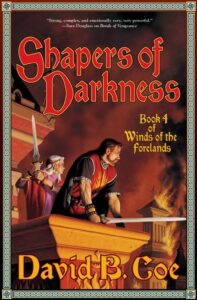 Okay, yes, I’m making light, poking fun at myself and my fellow writers. But fears such as these really do lie at the heart of most “trust your reader” moments. And so we fill our stories with unnecessary explanations, with redundancies that are intended to remind, but that wind up serving no purpose, with statements of the obvious and the already-known that serve only to clutter our prose and our storytelling.
Okay, yes, I’m making light, poking fun at myself and my fellow writers. But fears such as these really do lie at the heart of most “trust your reader” moments. And so we fill our stories with unnecessary explanations, with redundancies that are intended to remind, but that wind up serving no purpose, with statements of the obvious and the already-known that serve only to clutter our prose and our storytelling.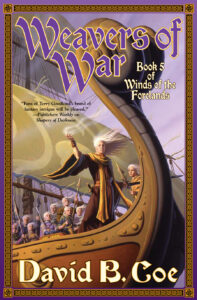 As a result, the first volume of the series was originally 220,000 words long. Yes, that’s right. Book II was about 215,000, and the later volumes were each about 160,000. They are big freakin’ books. Now, to be clear, there are other things that make them too wordy, and I’m fixing those as well. And the fact is, these are big stories and even after I have edited them, the first book will still weigh in at well over 200,000 words. My point is, they are longer than they need to be. They are cluttered with stuff my readers don’t need, and all that stuff gets in the way of the many, many good things I have done with my characters and setting and plot and prose.
As a result, the first volume of the series was originally 220,000 words long. Yes, that’s right. Book II was about 215,000, and the later volumes were each about 160,000. They are big freakin’ books. Now, to be clear, there are other things that make them too wordy, and I’m fixing those as well. And the fact is, these are big stories and even after I have edited them, the first book will still weigh in at well over 200,000 words. My point is, they are longer than they need to be. They are cluttered with stuff my readers don’t need, and all that stuff gets in the way of the many, many good things I have done with my characters and setting and plot and prose.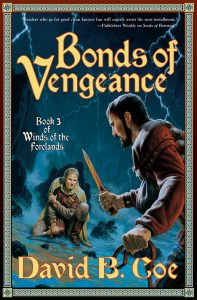 Many years back, while I was working on one of the middle books in my Winds of the Forelands quintet, my second series, I came downstairs after a particularly frustrating day of writing and started whining to Nancy about my manuscript. It was terrible, I told her. There was no story there, no way to complete the narrative I’d begun. The book was a disaster, and I might well have to scrap the whole thing.
Many years back, while I was working on one of the middle books in my Winds of the Forelands quintet, my second series, I came downstairs after a particularly frustrating day of writing and started whining to Nancy about my manuscript. It was terrible, I told her. There was no story there, no way to complete the narrative I’d begun. The book was a disaster, and I might well have to scrap the whole thing.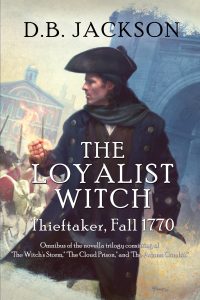 But at the very least, we need to see our main heroes grappling with what they have endured and setting their sights on what is next for them. We don’t need this for every character but we need it for the key ones. Ask yourself, “whose book is this?” For me, this is sometimes quite clear. With the Thieftaker books, every story is Ethan’s. And so I let my readers see Ethan settling back into life with Kannice and making a new, fragile peace with Sephira, or something like that. With other projects, though, “Whose book is this?” can be more complicated. In the Islevale books — my time travel/epic fantasy trilogy — I needed to tie off the loose ends of several plot threads: Tobias and Mara, Droë, and a few others. Each had their “Louis” moment at the end of the last book, and also some sense of closure at the ends of the first two volumes.
But at the very least, we need to see our main heroes grappling with what they have endured and setting their sights on what is next for them. We don’t need this for every character but we need it for the key ones. Ask yourself, “whose book is this?” For me, this is sometimes quite clear. With the Thieftaker books, every story is Ethan’s. And so I let my readers see Ethan settling back into life with Kannice and making a new, fragile peace with Sephira, or something like that. With other projects, though, “Whose book is this?” can be more complicated. In the Islevale books — my time travel/epic fantasy trilogy — I needed to tie off the loose ends of several plot threads: Tobias and Mara, Droë, and a few others. Each had their “Louis” moment at the end of the last book, and also some sense of closure at the ends of the first two volumes. Why do I do this? Why am I suggesting you do it, too? Because while we are telling stories, our books are about more than plot, more than action and intrigue and suspense. Our books are about people. Not humans, necessarily, but people certainly. If we do our jobs as writers, our readers will be absorbed by our narratives, but more importantly, they will become attached to our characters. And they will want to see more than just the big moment when those characters prevail (or not). They will want to see a bit of what comes after.
Why do I do this? Why am I suggesting you do it, too? Because while we are telling stories, our books are about more than plot, more than action and intrigue and suspense. Our books are about people. Not humans, necessarily, but people certainly. If we do our jobs as writers, our readers will be absorbed by our narratives, but more importantly, they will become attached to our characters. And they will want to see more than just the big moment when those characters prevail (or not). They will want to see a bit of what comes after.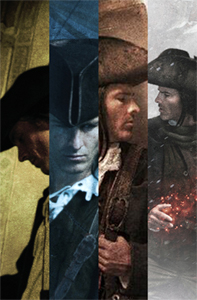 Then there are people like me. Some books, I outline in a good deal of detail. The Thieftaker novels demand preparation of this sort because I am tying together fictional and historical timelines, trying to make my story meld with established events. The Islevale books — time-travel epic fantasies — should have demanded similar planning. But for reasons I still have not fully grasped, all three books defied my efforts to outline. I simply couldn’t plot the books ahead of time. I tried for months (literally) to outline the first book, Time’s Children, and finally my wife said, “Maybe you just need to write it.”
Then there are people like me. Some books, I outline in a good deal of detail. The Thieftaker novels demand preparation of this sort because I am tying together fictional and historical timelines, trying to make my story meld with established events. The Islevale books — time-travel epic fantasies — should have demanded similar planning. But for reasons I still have not fully grasped, all three books defied my efforts to outline. I simply couldn’t plot the books ahead of time. I tried for months (literally) to outline the first book, Time’s Children, and finally my wife said, “Maybe you just need to write it.”  That’s what I did, and the result was a first draft that needed extensive reworking. When I began book II, Time’s Demon, I ran into the same problem. I didn’t even try to outline Time’s Assassin, the third and final volume. I knew it would be a waste of time. All three books needed extensive editing, more than I usually need to do. But they wound up being far and away the finest books I’ve written.
That’s what I did, and the result was a first draft that needed extensive reworking. When I began book II, Time’s Demon, I ran into the same problem. I didn’t even try to outline Time’s Assassin, the third and final volume. I knew it would be a waste of time. All three books needed extensive editing, more than I usually need to do. But they wound up being far and away the finest books I’ve written.